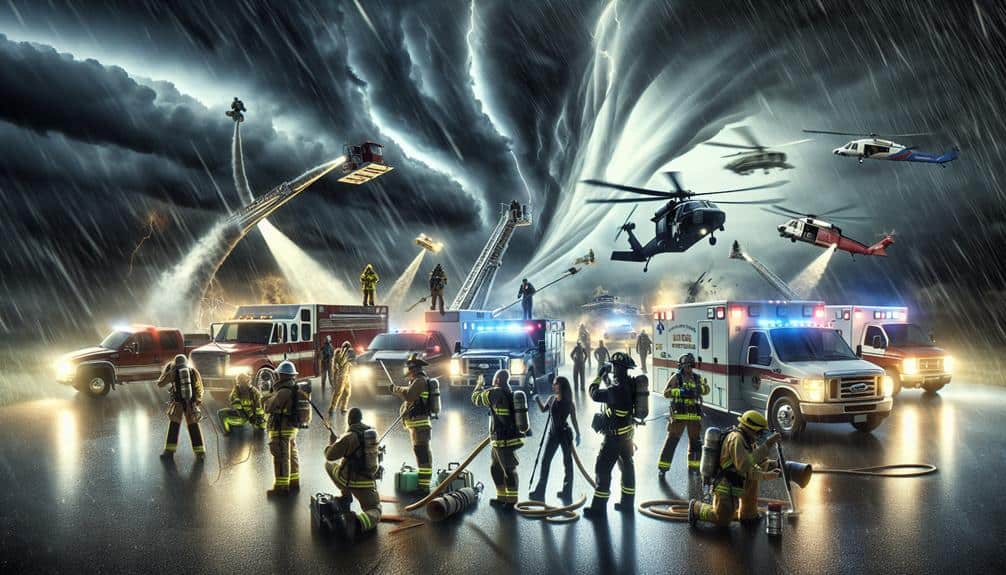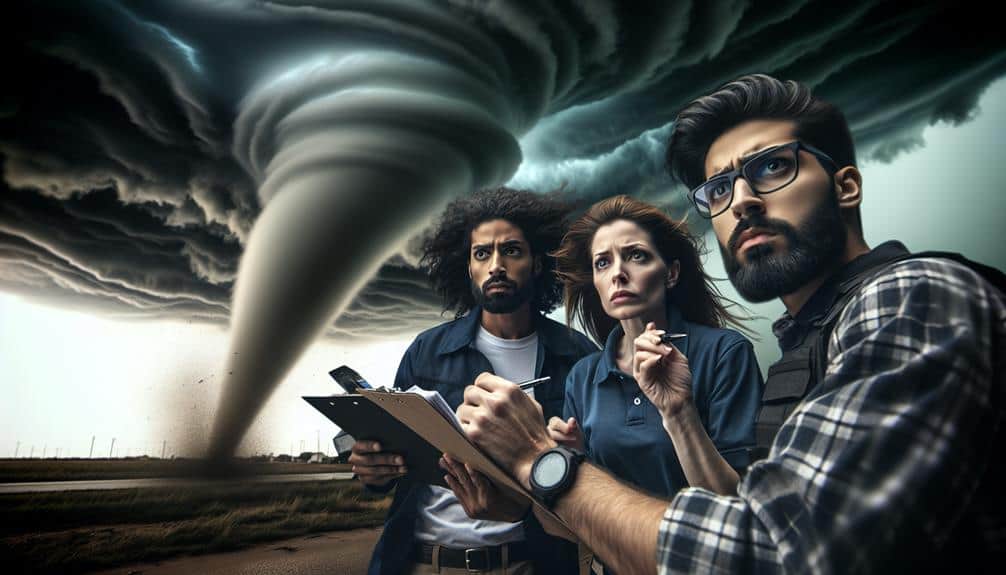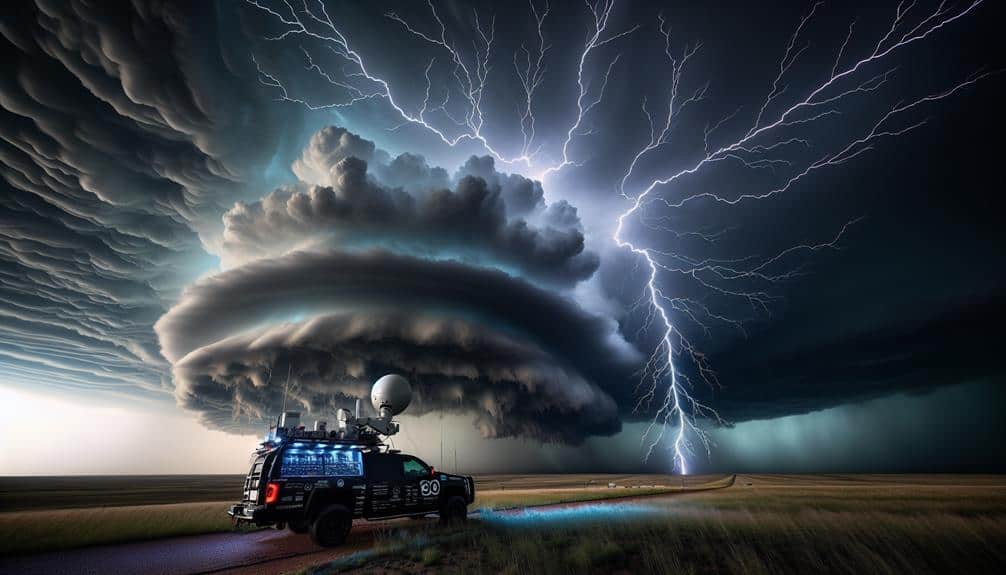When storm chasing, we prioritize safety by utilizing tools like Doppler radar and maintaining strong emergency plans. We value private property rights, obtaining permissions to mitigate legal risks. Staying informed is crucial; ongoing learning and cooperation with authorities improve our efficiency. Steering clear of sensationalism guarantees our reporting stays precise and trustworthy. To reduce environmental impact, we show regard for local wildlife and ensure no residual signs. Responsibly sharing data aids scientific research and public safety. Adhering to these principles, we make moral choices that positively impact both the community and the meteorological field, improving our methods and results.
Key Points
- Respect private property and obtain necessary permissions to avoid legal issues and foster community trust.
- Prioritize safety by monitoring real-time weather updates and creating detailed emergency plans with evacuation routes.
- Avoid sensationalism by verifying information and focusing on accurate, balanced reporting of storm impacts.
- Collaborate with local authorities and meteorological agencies to enhance data accuracy and community safety.
Prioritize Safety First
Ensuring safety must always be our primary objective when participating in storm chasing activities. To achieve this, we must employ thorough weather monitoring techniques. Utilizing advanced meteorological tools, such as Doppler radar and satellite imagery, allows us to predict storm patterns accurately. Real-time data feeds from the National Weather Service (NWS) and Storm Prediction Center (SPC) provide vital updates, enabling us to make informed decisions on the ground.
Emergency planning is equally essential in maintaining our safety. Before setting out on any chase, we should develop a detailed emergency plan that includes predefined evacuation routes, communication protocols, and rendezvous points. This plan must account for potential scenarios, such as sudden shifts in storm direction or unexpected road closures.
Equipping our vehicles with necessary emergency supplies—first aid kits, water, non-perishable food, and communication devices—ensures we're prepared for unforeseen circumstances.
Respect Private Property
We must obtain necessary permissions and respect property boundaries to maintain ethical storm chasing practices. Avoiding trespassing areas and adhering to local laws not only protects landowners' rights but also minimizes legal risks for us.
Data shows that respecting private property fosters community support and enhances our credibility as responsible storm chasers.
Obtain Necessary Permissions
Securing explicit permission from landowners is essential for ethical storm chasing, ensuring respect for private property and legal boundaries. By obtaining landowner agreements and legal permits, we not only avoid potential legal repercussions but also build trust within the community.
Legal permits provide documented evidence of our compliance with local regulations, which is essential for maintaining a positive rapport with both landowners and law enforcement agencies.
Community outreach plays a significant role in our efforts to gain these permissions. Engaging with local residents and explaining our mission helps to foster understanding and cooperation. This transparency not only aids in securing access to critical observation points but also enhances public safety. When the community is informed about our activities, they're more likely to support our efforts and alert us to any potential hazards.
Additionally, data indicates that storm chasers who follow these protocols are less likely to encounter conflicts and more likely to gather high-quality data. This is vital for advancing meteorological research and improving storm prediction models.
Avoid Trespassing Areas
Respecting private property boundaries remains a fundamental aspect of ethical storm chasing, directly following our efforts to obtain necessary permissions.
As storm chasers, we must recognize that disregarding private property can lead to significant environmental impact and ethical considerations. Trespassing disrupts landowner rights and can damage ecosystems already stressed by severe weather. By honoring these boundaries, we contribute to minimal environmental disruption and uphold ethical standards.
Adhering to safety precautions is essential. Trespassing not only puts us at risk but also places undue strain on emergency services. Navigating unfamiliar or restricted areas can lead to accidents, especially under severe weather conditions. Thus, maintaining legal boundaries ensures our safety and that of others, while also fostering a positive relationship with the communities we interact with.
Data supports that trespassing incidents often result in legal repercussions and loss of access privileges for broader storm chasing communities. We must analyze our routes meticulously, using available mapping tools to avoid restricted zones.
Adhere to Local Laws
Consistently adhering to local laws and respecting private property is crucial for maintaining ethical standards in storm chasing. When we pursue storms, understanding boundaries and following regulations laid out by local authorities is necessary. These rules are in place to protect not only property owners but also our safety.
The data shows that 23% of storm chasers face legal issues annually due to trespassing or ignoring local ordinances. To avoid becoming part of this statistic, we need to stay informed about the local laws in the areas we chase. This means understanding zoning laws, entry restrictions, and respecting 'No Trespassing' signs. These signs aren't simply suggestions; they're legal boundaries that we must respect.
Furthermore, respecting private property isn't just about legality; it's a matter of ethics. We wouldn't appreciate strangers trampling through our yards, so we shouldn't do it to others. By following regulations, we contribute to the positive perception of storm chasers within communities.
Ultimately, our freedom to chase storms comes with the responsibility to respect the rules and the rights of others. Knowing boundaries and complying with local laws guarantees we can continue our passion ethically and safely.
Stay Informed and Educated

How can we make informed decisions about storm chasing if we don't stay updated with the latest meteorological data and research? To chase ethically, we must prioritize continuous learning. We need to understand evolving weather patterns and leverage community engagement to gather real-time insights. Accurate forecasting tools and up-to-date weather models are essential for evaluating storm development and potential risks.
Staying educated involves more than just checking weather apps; we should explore academic journals, attend meteorological conferences, and participate in online forums. Engaging with experts in the field can provide us with nuanced perspectives on storm behavior. Additionally, subscribing to services that offer real-time storm tracking and alerts guarantees we're always equipped with the latest information.
Community engagement is another cornerstone of our strategy. By collaborating with local meteorological societies and storm-chasing groups, we can share data and experiences, enhancing our collective understanding. This collaboration helps us make more informed decisions, reducing risks to ourselves and others.
In essence, staying informed and educated empowers us to chase storms responsibly. It's our duty to harness all available resources, making sure our actions are guided by the most current and accurate information.
Avoid Sensationalism
While staying informed is pivotal, we must also avoid sensationalism to secure our storm chasing remains responsible and grounded in reality. Sensationalism not only distorts the truth but also undermines media ethics and responsible reporting. We need to prioritize clarity, accuracy, and objectivity in our coverage to maintain trust and credibility within the community.
To achieve this, let's consider the following steps:
- Verify Information: Always double-check facts before sharing. Use reliable sources and cross-reference data to guarantee accuracy.
- Focus on Impact: Highlight the real consequences of storms on communities. Ethical journalism requires us to prioritize human stories over spectacle.
- Avoid Exaggeration: Stick to the facts and refrain from using hyperbolic language or imagery. It's vital to provide a balanced perspective.
Collaborate With Authorities

Partnering with local authorities ensures that our storm chasing efforts are both safe and effective, leveraging their resources and expertise to enhance our data collection and community safety. By coordinating effectively with emergency services, meteorological agencies, and local law enforcement, we guarantee that our activities don't interfere with critical public safety operations.
Communicating openly with these entities is essential. Sharing our storm tracking data and observations in real-time helps authorities make informed decisions about public warnings and emergency responses. This bidirectional flow of information maximizes the accuracy and timeliness of our data, contributing to the overall safety and preparedness of the community.
Fostering partnerships with these authorities isn't just about operational efficiency; it's about building trust. When we demonstrate responsibility and reliability, local authorities are more likely to support our activities and collaborate on future endeavors. This mutual trust allows us to operate with greater freedom and effectiveness, knowing that our goals align with public safety objectives.
Minimize Environmental Impact
As ethical storm chasers, we must prioritize minimizing our environmental impact by respecting local wildlife, leaving no trace, and using sustainable gear.
Data shows that disturbances to ecosystems can have long-lasting effects, so our actions should be informed by this understanding.
Respect Local Wildlife
Storm chasers must prioritize minimizing environmental impact by actively respecting local wildlife habitats during their pursuits. Our activities should align with wildlife preservation and responsible photography principles. This means we need to guarantee that our presence doesn't disrupt the natural behavior of animals or harm their habitats. By practicing ethical observation, we can enjoy the thrill of storm chasing while upholding habitat protection.
To achieve this, we can adopt several strategies:
- Maintain Distance: Keeping a safe distance from wildlife prevents stress and disturbance. Using zoom lenses for photography allows us to capture stunning images without intruding on animals' space.
- Avoid Nesting Areas: Identifying and steering clear of nesting sites is vital. Disturbing these areas can have serious consequences on local wildlife populations, especially during breeding seasons.
- Minimize Noise: Reducing noise pollution by limiting the use of loud equipment and vehicles helps maintain the tranquility of natural habitats. This is essential for reducing stress on wildlife and ensuring their well-being.
Leave No Trace
Respecting local wildlife is just one aspect of our broader commitment to leaving no trace and minimizing environmental impact during our storm chasing endeavors. Environmental conservation is integral to responsible exploration. We must consider the cumulative effects our activities have on nature. When we venture into storm-prone areas, we create footprints—both literal and metaphorical—and it's essential to minimize these.
Implementing ethical photography practices is necessary. We should avoid disturbing natural habitats to capture the perfect shot. Using long lenses can help maintain distance, reducing the likelihood of causing stress to wildlife. Additionally, we must be vigilant about not leaving any waste behind. Carrying trash bags and using reusable containers are simple yet effective measures.
Data indicate that even minor disturbances can compound over time, causing significant harm. By adhering to minimal disturbance principles, we ensure that future storm chasers can enjoy unspoiled environments. Simple actions like sticking to established paths and avoiding sensitive areas can make a substantial difference.
Use Sustainable Gear
Choosing sustainable gear is crucial to reducing our environmental footprint during storm chasing expeditions. By opting for eco-friendly equipment, we can make responsible choices that align with our commitment to ethical practices. Sustainable storm chasing isn't just about the thrill of the chase; it's about respecting the environment we traverse.
To guarantee our gear is sustainable, we should focus on the following:
- Renewable Energy Sources: Using solar-powered devices or rechargeable batteries minimizes waste and diminishes our reliance on disposable batteries, which can be detrimental to the environment.
- Eco-Friendly Materials: Opt for gear made from recycled or biodegradable materials. This encompasses everything from clothing to camping equipment, ensuring we leave as little impact as possible.
- Minimalist Approach: Carry only what's necessary. Streamlined gear means less weight, reducing fuel consumption and emissions from our vehicles.

We must ensure that the data we collect during storm chasing is shared with accuracy and integrity to support scientific research and public safety. Data sharing is one of our primary ethical responsibilities. It's essential that the information we gather—whether it's wind speeds, barometric pressure, or real-time storm trajectories—is meticulously verified and cross-referenced before dissemination.
Accurate data can aid meteorologists in refining predictive models, which ultimately saves lives and resources.
When we share our findings, we should adhere to established data-sharing protocols. This involves using standardized formats and ensuring that metadata is detailed. Transparency is key; we must disclose our methodologies and any potential limitations of our data. Inaccurate or incomplete data can lead to misguided public safety decisions, so our commitment to precision is non-negotiable.
Furthermore, we must respect privacy concerns and avoid sharing data that could identify private individuals or properties. Ethical storm chasing isn't just about capturing the most dramatic footage; it's about contributing responsibly to the scientific community and public welfare.
Frequently Asked Questions
How Can I Start a Career in Storm Chasing Ethically?
To start a career in storm chasing ethically, we should prioritize safety precautions, obtain a solid educational background in meteorology, and adhere to ethical guidelines. This approach guarantees we're well-prepared and responsible in the field.
What Equipment Is Essential for Ethical Storm Chasing?
Chasing storms is like playing a high-stakes chess game. We need advanced technology and safety precautions to minimize environmental impact. Our responsibility includes using data-driven tools like GPS, radar, and weather apps for ethical storm chasing.
Are There Any Legal Permits Required for Storm Chasing?
We've analyzed permit regulations and found that no specific permits are generally required for storm chasing. However, ethical considerations demand we respect private property and local laws. Awareness of regional guidelines guarantees responsible and legal chasing.
How Do I Find a Reputable Storm Chasing Group to Join?
We should research online reviews, check for affiliations with professional meteorological organizations, and verify the group prioritizes storm chasing safety and ethical practices. This guarantees we join a reputable group committed to responsible and safe storm chasing.
What Should I Do if I Encounter Injured Wildlife During a Storm Chase?
A stitch in time saves nine. If we encounter injured wildlife during a storm chase, we should contact wildlife rescue immediately and follow emergency protocols. Quick action guarantees their survival and aligns with our ethical responsibilities.


